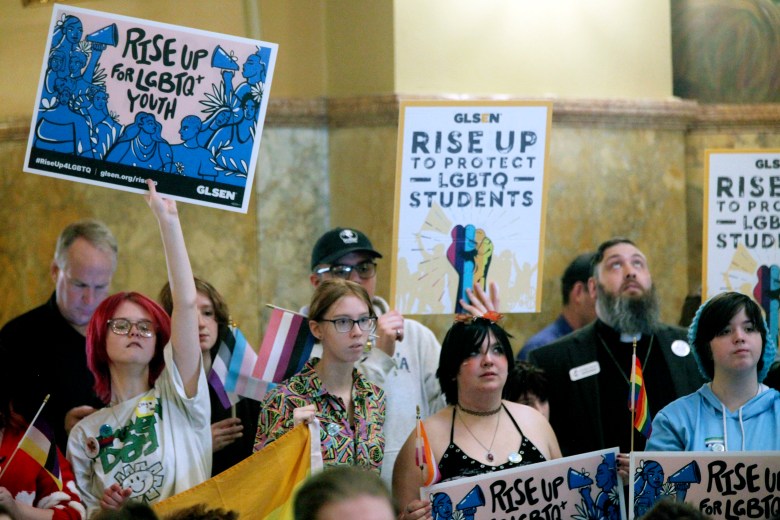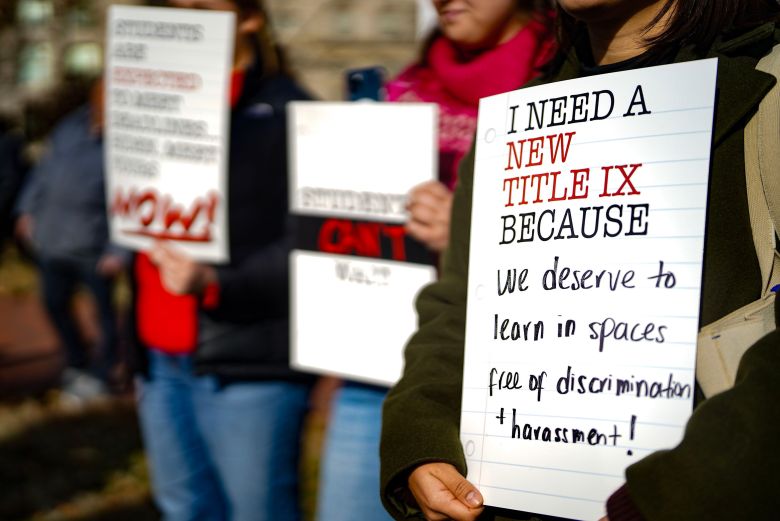In Sheridan County School District #3 in northern Wyoming, where it can take an hour on the bus each way for students to attend the K-12 Clearmont School, the Biden administration’s rewrite of Title IX rules for addressing sex-based discrimination was welcomed — by some.

The new rules, said Chase Christensen, the school’s principal and superintendent of the district, offer a rural community like his a streamlined process that “can alleviate the burdensome investigation process for districts and for schools.” His district spans 1,000 square miles and serves 85 pupils.
“I think they were a large move forward,” Christensen said.
Related: Become a lifelong learner. Subscribe to our free weekly newsletter to receive our comprehensive reporting directly in your inbox.
The regulation that took effect this month was meant to replace Trump-era rules set in 2020 that, among other conditions, typically require multiple impartial adults to investigate and respond to allegations of sex-based discrimination. That demand, Christensen said, especially strains small communities and districts with limited personnel. Plus, he said, those bringing a complaint “are not wanting a remedy four months later,” but in a few days. “They are wanting to move on.”
But Wyoming and 25 other states sued to halt the Biden administration rules, and thus far, have succeeded in court. So in those states, plus a growing list of individual schools around the country, the new rules are blocked from taking effect.
The result is a messy legal landscape with school officials trying to figure out their obligations. In some cases, schools in the very same district are subject to different rules.
“It is creating so much more work and chaos,” said Emma Grasso Levine, the Title IX policy and senior program manager at the advocacy group Know Your IX. “Are we enforcing this rule or that rule?“
At the center of the court challenges is that the Biden administration’s new rules, issued in April, expand the definition of “sex” to include sexual orientation and gender identity. This aligns with protections extended in the workplace by a 2020 Supreme Court ruling and offers greater support for transgender students. That spurred lawsuits from political leaders in red states and groups including Moms for Liberty, explicitly objecting to this broader definition. As a result, several judges blocked the new regulations, which also are intended to protect students who are pregnant or who have terminated a pregnancy, from taking effect in certain states, as well as in schools attended by children of members of Moms for Liberty and two other groups that were plaintiffs in one of the lawsuits.
Opponents of the Biden-era regulations have cast the court decisions as a victory. In Missouri, Attorney General Andrew Bailey described the court order blocking the law in his state as “a huge win,” arguing that the proposed new rules were “a slap in the face to every woman in America.” The rules, he said in a press release, “would have forced educational programs that receive federal money to accept a radical transgender ideology.”
Earlier this month, the Education Department made an emergency request to have the polarizing matter of protections based on gender identity or sexual orientation considered apart from the other provisions so that the new rule would not be on hold entirely in some states. On Aug. 16, the Supreme Court denied that request. The new rules do not address transgender athletes, which the department is taking up separately. But Grasso Levine said the rise of anti-LGBTQ sentiment around sports participation, along with laws barring transgender athletes and gender-affirming health care in some states, has helped to drive the objections to the Biden administration’s Title IX regulation.

Now there is confusion and frustration, both from those eager to protect LGBTQ+ youth through the expanded definition of whom the law protects — and school officials hungry for more streamlined rules around Title IX complaints.
“It would be nice if we could take a big-picture look at the update, rather than targeting a couple of words that didn’t match up ideologically,” said Christensen, the superintendent and principal in Wyoming, where a statewide injunction has kept the new rules from taking effect.
This is also a problem in populous states like Pennsylvania, said David Conn, a lawyer who has worked on Title IX and LGBTQ+ issues in schools for over a decade.
The old regulations “have these very detailed rules for how to handle a complaint” that, he said, are not a good fit for typical minor cases of student misconduct. Conn said the new guideline better serves the day-to-day needs at the K-12 level and “allows for informal resolution, which in school districts is a big deal.”
When the new rules went into effect, they represented “a significant step forward in improving policies for LGBTQ students,” said Brian Dittmeier, policy director for GLSEN, a group started by teachers in 1990 that advocates for LGBTQ+ individuals in K-12 education.
According to GLSEN data, 83 percent of LGBTQ+ students said they were assaulted or harassed because of their gender identity in school in 2021, and nearly 62 percent of them did not report it. Such findings, said Dittmeier, suggest “a gap of trust” and students “not feeling they were protected by school policies.”
Since it was passed in 1972, Title IX — just 37 words — has leaned on regulations to shape its enforcement. Each administration has tweaked the language, but the Biden administration’s more detailed review, which included public comment, sought to give the new rules “the force of law” in contrast to the Obama administration’s “Dear Colleague” letter guidance, said Suzanne Eckes, Susan S. Engeleiter Chair in Education Law, Policy, and Practice at the University of Wisconsin.
She said that the new rules interpreting the Title IX phrase “on the basis of sex” as including sexual orientation and gender identity are in line with the June 2020 Supreme Court decision in Bostock v. Clayton County. That ruling found that sex-based employment protections under Title VII covered sexual orientation and gender identity, stating that “it is impossible to discriminate against a person for being homosexual or transgender without discriminating against that individual based on sex.”
Related: What education could look like under Trump and Vance
Eckes said an August 2020 case, Grimm v. Gloucester County School Board that asserted violations of Title IX and the Equal Protection Clause, found in favor of a trans student’s right to use the restroom matching their gender identity, citing Bostock in the opinion. “Title IX cases look at Title VII and Title VII cases look at Title IX. This is nothing new,” said Eckes.
Yet that is exactly the conflict at play. Several courts blocked the new Title IX rules because of the expanded definition of “sex.” Kansas U.S. District Court Judge John Broomes ruled that “the reasoning of Bostock does not automatically transfer for the Title IX context.” He said the new rules fail to define “gender identity” and that “the unambiguous plain language of the statutory provisions and the legislative history make clear that the term ‘sex’ means the traditional biological concept of biological sex in which there are only two sexes, male and female.”
The case before Broomes was brought by political leaders in Kansas, Alaska, Utah and Wyoming, along with Moms for Liberty, Young America’s Foundation and Female Athletes United. Broomes ruled that his injunction applied to the four states, and to schools attended by children of members of Moms for Liberty and the suit’s other plaintiffs. Following the ruling, Moms for Liberty co-founders Tiffany Justice and Tina Descovich described it as victory, stating that “gender ideology does not belong in public schools and we are glad the courts made the correct call to protect parental rights.”
The groups have urged members to request the schools and colleges their children attend be exempt from the Biden administration rule; Broomes is allowing the list that already includes hundreds of individual schools not covered by statewide injunctions to expand. As a result, Moms for Liberty leaders, ahead of their annual gathering in Washington, D.C., this week, are pitching free membership that “ensures your child’s school is included in this exemption.” That has led to the situation where in states, including Pennsylvania, not subject to a statewide injunction, one school can be governed by the new rules while another in the same district is not.

The key point of contention in the lawsuits, said Eckes, centers on transgender students’ use of restrooms, the most litigated issue involving transgender students in schools. While the Supreme Court has so far avoided taking up such a case, she said, “if this continues to cause chaos across the United States or another case comes up around trans access to restrooms,” that could change. Right now, as a practical matter, she said, case law has repeatedly supported the right of students to use the restroom that aligns with their gender identity.
Some states, like Pennsylvania, have strong anti-discrimination laws. As a result, the injunction applied to individual schools “is much ado about nothing,” said Conn, the Pennsylvania attorney and Title IX expert. Plus, he said, applicable court decisions support protections for transgender students in the state. “Any school district that said, ‘What do we have to do about bathrooms?’ My answer is that you have to let those students use the bathroom consistent with their gender identity. Full stop,” he said.
Related: How could Project 2025 change education?
That, however, may not be the case everywhere. Plus, there is the on-the-ground reality that court cases are one thing, but life in a school for LGBTQ+ students is another. Marlene Pray, director of The Rainbow Room in Bucks County, Pennsylvania, a gathering place for queer youth, said students have told her they are anxious about the start of school. Some who have already returned have faced struggles — verbal attacks and isolation, harassment, and one, she said, shared that they “had trash thrown at me in the cafeteria.”
Pushback to the new Title IX rules is just part of a larger social challenge for LGBTQ+ students, said Pray. “Their daily experience of being bullied and being targeted has not changed. And it’s not because of some list that Moms for Liberty gave some right-wing judge.”
The problem, said Pray, is “the hundreds of legislative plans and policies that are targeting them.”
Although the result of the lawsuits is one set of colleges and schools operating under a four-year old regulation and another set operating under a brand new one, the underlying Title IX law is unchanged, noted Anya Marino, director of LGBTQI+ Equality at the National Women’s Law Center.
The legal action that resulted in blocking the newer rule in some places “does not eliminate students’ ability to bring claims under the statute, and it certainly does not eliminate schools’ obligation to uphold Title IX’s dictate.” Marino pointed to a guide from the ACLU this month that states as much. “I don’t think there should be any confusion regarding schools’ obligation to protect students.”
This story about Title IX regulations was produced by The Hechinger Report, a nonprofit, independent news organization focused on inequality and innovation in education. Sign up for the Hechinger newsletter.



